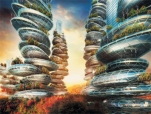The Asian Cairns

Outstanding Belgian architect Vincent Callebaut is known as specializing in sustainable projects for the future Ecopolises, always with a view to help the planet. His most recent project is Asian Cairns developed for Chinese city of Shenzhen aims against a rural exodus recurrent and uncontrolled urbanization, proposing a new sort of skyscrapers and combining it with biology, information and communication technologies.
Farmskyscrapers: Rural Life in the Metropolis
At the end of 2011 in China, the number of inhabitants in the cities exceeded the number of inhabitants in the countryside. Whereas 30 years ago only one Chinese person out of five lived in the city, the city-dwellers represent now 51.27% of the total population of 1 347 billion of people. This urban population is supposed to increase to 800 million of inhabitants within 2020 spread mainly in 221 cities of at least one million of inhabitants (versus only 40 in Europe of the same scale) and 23 megapolises of more than five million of inhabitants.
According to Li Jianmin, an expert in demography from the Tianjin University, the Chinese population will be urban at 75% within 2030! Facing this massive rural exodus and the unrestrained acceleration of the urbanization, the future models of the – green, dense and connected – cities must be rethought from now on! The challenge is to create a fertile urbanization with zero carbon emission and with positive energy. This means producing more energy that it consumes, in order to conciliate the economic development with the protection of the planet. The standard of living of everyone will thus be increased by respecting at the same time the standard of living of everybody.
Eco-urbanism
The cities are currently responsible for 75% of the worldwide consumption of energy and they reject 80% of worldwide emissions of CO2. The contemporary urban model is thus ultra-energy consuming and works on the importation of wealth and natural resources on the one hand, and on the exportation of the pollution and waste on the other hand. This loop of energetic flows can be avoided by repatriating the countryside and the farming production modes in the heart of the city by the creation of green lungs, farmscrapers in vertical storeys and by the implantation of wind and solar power stations. The production sites of food and energy resources will be thus reintegrated in the heart of the consumption sites! The buildings with positive energies must become the norm and reduce the carbon print on the mid-term.
Full version you can download here
 Text : Vincent Callebaut,
Text : Vincent Callebaut,
illustrations by Vincent Callebaut Architect


